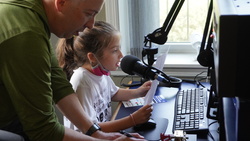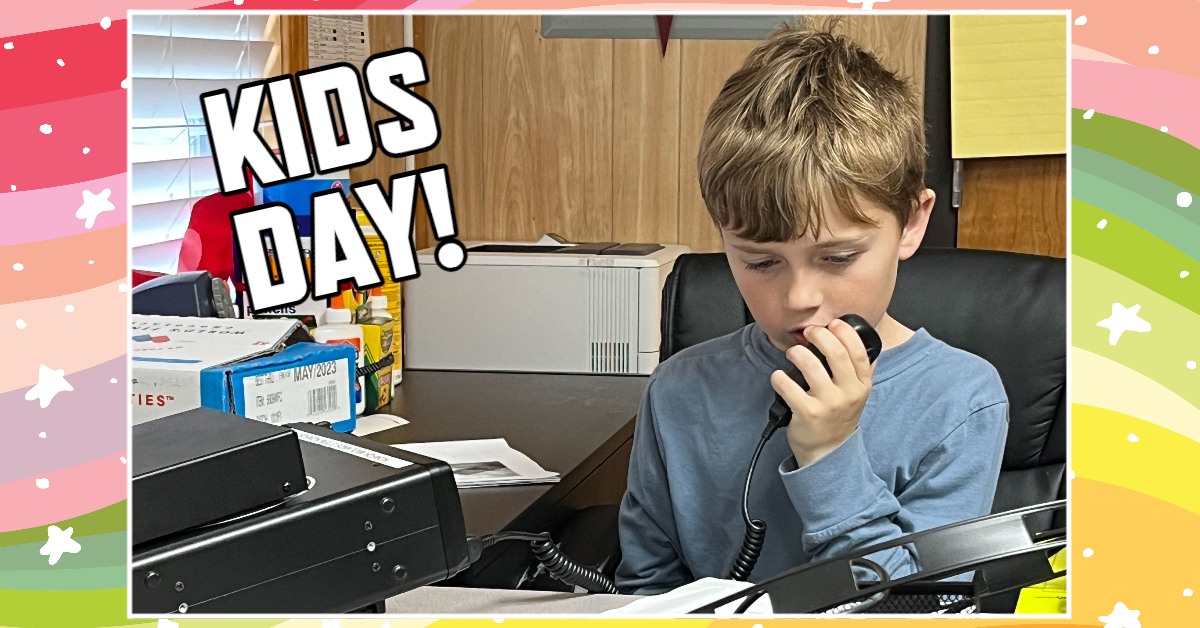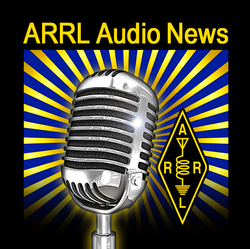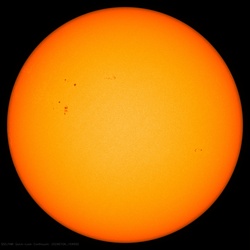 January 4, 2024 John E. Ross, KD8IDJ, Editor
| ||||||
Friday: Teenage Hams on TODAY Show Tomorrow morning, January 5, 2024, a story about the Harbor Creek High School students making amateur radio contact with astronauts on the International Space Station is expected to air on NBC's TODAY, according to a promotion for the segment that aired on Thursday's broadcast. Journalist Harry Smith and a crew from the top-rated national morning show traveled to Harborcreek, Pennsylvania for the December 11, 2023 Amateur Radio on the International Space Station (ARISS) contact. As ARRL News reported at the time, the program at the school is a success story of the ARRL Teachers Institute on Wireless Technology. ARRL has worked with NBC producers to provide additional footage to support the story.
A still frame from the Thursday, January 4, 2024 broadcast of TODAY on NBC, promoting a story about teenage ham radio operators contacting astronauts on the International Space Station through ARISS. According to the broadcast, the segment is planned to run on Friday, January 5, 2023. Check your local listings. [Image: NBC Universal] ARRL Kids Day in on January 6! Twice a year, ARRL offers an event designed to promote amateur radio to youth. On ARRL Kids Day, which will be held this year on January 6, 2024, you can share the excitement with your own kids, grandkids, a Scout troop, a church, or the general public! ARRL Kids Day is designed to give on-the-air experience to young people and to foster interest in getting a license of their own.
It is also intended to give older hams a chance to share their station and love for amateur radio with their children. ARRL Kids Day always runs from 1800 UTC through 2359 UTC. Operate as much or as little as you like. Here are some suggested bands and frequencies:
You can also use your favorite local repeater, with permission from the repeater's sponsor. Be sure to observe third-party restrictions when making DX contacts. All participants are eligible to receive a colorful certificate. You can download this certificate and complete it with the participant's name and the date of the contact. Alternatively, you can send a 9" x 12" self-addressed stamped envelope to the following address: Kids Day Certificate Request All participants are encouraged to post their story and thumbnail photos to the Kids Day Soapbox page. Tell the world about your operations, the fun you had, and the contacts you made! Readers of QST and other ARRL publications love to see hams having fun, and youths are our future! Please send us your high-resolution (500 KB - 3 MB) photos of youth in action, whether they're operating, setting up antennas, or having fun. You can send them (email preferred) to contests@arrl.org , or you can mail files or printed photos to ARRL Headquarters at 225 Main St, Newington, Connecticut (see the full mailing address above).
We must have a completed release form in order to include youth photos (younger than 18 years of age) in ARRL publications. The second ARRL Kids Day of the year will be on Saturday, June 15, 2024. HamSCI 2024 Workshop Ham Radio Science Citizen Investigation (HamSCI) will hold its sixth annual workshop on March 22 - 23, 2024, at Case Western Reserve University in Cleveland, Ohio. The 2024 workshop's theme will be "Alignments" - specifically those between the Sun, Moon, and Earth; collegiate amateur radio recreation and science, technology, engineering, and math (STEM) curricula; data collection and analysis, and professional and citizen science. Workshop participants will prepare for the solar eclipse taking place on April 8, 2024, which will be seen in totality from Cleveland. HamSCI's main interest is using amateur radio for the characterization and study of ionospheric phenomena like traveling ionospheric disturbances, sporadic E, solar flares, geomagnetic storms, the 2024 total solar eclipse, and other space weather events. To facilitate this science, continued development of the HamSCI Personal Space Weather Station and discussion about integrating amateur radio into the collegiate curriculum will also take place during the workshop. Registration is now open, and the deadline is March 1, 2024. HamSCI is also accepting presentations relating to amateur radio and science -- particularly space and atmospheric science, space weather, and radio astronomy -- that analyze the ionosphere, propose ideas for the Personal Space Weather Station, and discuss the 2024 eclipse. Presentations should be the form of talks, posters, lightning talks, and demonstrations. The Science Program Committee will be accepting abstracts and presentations. If you would like to present, please submit your abstract by February 10, 2024. Presenters will be notified about their acceptance by March 1, 2024. Questions about abstracts should be emailed to Nathaniel Frissell, W2NAF, at hamsci@hamsci.org. For registration and additional information about the event, visit HamSCI Workshop 2024 | HamSCI. Amateur Radio in the News ARRL Public Information Officers, Coordinators, and many other member-volunteers help keep amateur radio and ARRL in the news. "Nine TVCC Students Receive their Radio Technician License" / Athens Daily Review (Texas) December 29, 2023 -Trinity Valley Community College. "Teen Radio Program on Amateur Radio (Spanish)" / WIPR-AM (Puerto Rico) January 2, 2024. ARRL Podcasts On the Air The December 2023 episode of the On the Air podcast ties into a feature in the November/December issue called "Bits and Baud," which discussed important elements of digital communication, namely the quantity of information a transmission delivers -- known as bit rate -- and the rate of speed at which the information is delivered, which is known as baud rate. In this podcast episode, we're joined by the article's author, former QST Editor Steve Ford, WB8IMY, who explains more about the differences between bit rate and baud rate, as well as why hams are concerned with these measurements in the first place. ARRL Audio News The On the Air podcast and ARRL Audio News are available on blubrry, iTunes, and Apple Podcasts -- On the Air | ARRL Audio News. Announcements Amateur Radio on the International Space Station (ARISS) has announced the schools/host organizations selected for scheduled contacts with International Space Station (ISS) crew from July to December 2024. The primary goals of the ARISS program are to engage young people in science, technology, engineering, arts, and math (STEAM) activities and to raise their awareness of space communications, radio communications, space exploration, and related areas of study and career possibilities. ARISS anticipates NASA will be able to provide scheduling opportunities for the six host organizations as they complete equipment plans that allow them to execute ham radio contacts. Once their equipment plans are approved by ARISS, the ISS contacts will be scheduled as availability allows. The selected schools and host organizations are:
ARISS is a cooperative venture of international amateur radio societies and the space agencies that support the ISS. In the US, participating organizations include NASA's Space Communications and Navigation program (SCaN), the ISS National Laboratory -- Space Station Explorers, ARRL, and AMSAT. For more information, visit http://www.ariss.org. In Brief... A YouTube telethon fundraiser held on December 22, 2023, and hosted by several popular ham radio YouTubers from the Ham Radio Tube channel helped raise money for the ARRL Teachers Institute (TI) on Wireless Technology. ARRL Education and Learning Manager Steve Goodgame, K5ATA, was featured on the telethon. "We streamed for over 5 hours on Mike's, K8MRD, YouTube channel," said Goodgame. "The total amount raised was over $18,000. The YouTube community has rallied behind the TI and expressed interest in doing similar events on a recurring basis." The TI is entirely donor-funded and has seen many recent successes. In 2023, 65 educators attended, and 95% of them are now licensed hams; 20 of them received their licenses during the TI and 12 more upgraded their license class. Graduates of the program leave with equipment and instructional material to take into the classroom, allowing them to incorporate amateur radio into science, technology, engineering, and mathematics (STEM) education. A replay of the event can be watched at ARRL Teachers Institute Fundraiser With Steve K5ATA (youtube.com). To directly support the TI, visit www.arrl.org/GiveToSTEM. A special 6-month event designed to celebrate the 90th anniversary of the first official transmission of Radio Luxembourg Broadcasting has concluded. The event gave amateur radio operators and shortwave listeners around the world the opportunity to work or hear special event call sign LX90RTL. Overall, 27,922 contacts were made with LX90RTL, 13.4% of participating stations were from the US, 11.3% were from Germany, and 214 were from DXCC entities, and they included all 40 CQ zones and all 50 US states. More details are available at https://www.qrz.com/db/LX90RTL) and RadioLuxembourg. The K7RA Solar Update Tad Cook, K7RA, of Seattle, Washington, reports for this week's ARRL Propagation Bulletin, ARLP001:
Only four new sunspot groups emerged over the past week: one on December 28, 2023, another on December 31, and two more on January 2 and 3, 2024. Solar indices sank. The average daily sunspot number declined from 114.4 to 63.4, and the average daily solar flux declined from 172.6 to 141.9. Average daily planetary A index rose from 8.4 to 6.7, and middle latitude numbers rose from 4 to 5.1. Predicted solar flux over the next few weeks looks moderate. It will be 145 on January 4 - 5; 150 on January 6 - 8; 155 on January 9; 160 on January 10 - 11; 155 on January 12 - 14; 160, 165, 160, and 155 on January 15 - 18; 150 on January 19 - 21; 145 and 140 on January 22 - 23, and 135 on January 24 - 26. Predicted planetary A index is 8 on January 4; 5 on January 5 - 7; 10 on January 8 - 10, and 5 on January 11 - 26. Solar activity looks soft as of late, but perhaps we will see a double peak during this cycle. See an illustration comparing progress in the current cycle to the last cycle, month by month since each solar minimum, at: https://bit.ly/4aMBefh. The second chart from the top of the page is labeled "Solar Cycle Comparison." The red line is the last cycle, and it was probably smoothed by monthly averages. The darker blue-green line is probably a conventional moving average with the points on the line smoothed over a year. The yellow line is the current cycle -- also probably smoothed over a year -- and the lighter blue-green line is the current cycle, which was probably smoothed with monthly numbers. This data looks promising for future activity. Sunspot numbers for December 28, 2023, through January 3, 2024, were 83, 92, 48, 55, 44, 59, and 63, with a mean of 63.4. The 10.7-centimeter flux was 146.7, 142.9, 139.7, 146.2, 135.7, 142.1, and 140.2, with a mean of 141.9. Estimated planetary A indices were 3, 6, 5, 4, 10, 8, and 11, with a mean of 6.7. Middle latitude A index was 2, 6, 4, 2, 6, 8, and 8, with a mean of 5.1. Send your tips, questions, or comments to k7ra@arrl.net. A comprehensive K7RA Solar Update is posted Fridays on the ARRL website. For more information concerning radio propagation, visit the ARRL Technical Information Service, read "What the Numbers Mean...," and check out the Propagation Page of Carl Luetzelschwab, K9LA. A propagation bulletin archive is available. For customizable propagation charts, visit the VOACAP Online for Ham Radio website. Share your reports and observations. A weekly, full report is posted on ARRL News. Just Ahead in Radiosport
Visit the ARRL Contest Calendar for more events and information. Upcoming Section, State, and Division Conventions
Search the ARRL Hamfest and Convention Database to find events in your area. Have News for ARRL? Submissions for the ARRL Letter and ARRL News can be sent to news@arrl.org. -- John E. Ross, KD8IDJ, ARRL News Editor
ARRL -- Your One-Stop Resource for
Free of charge to ARRL members...
| ||||||




 The event is meant to bring together the amateur radio community and professional scientists.
The event is meant to bring together the amateur radio community and professional scientists..jpg)
 Listen to
Listen to 
-Blue.jpg)








